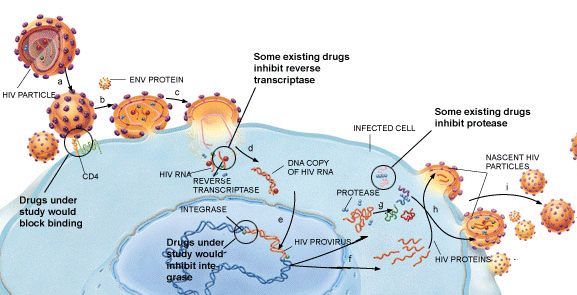

What is known about HIV?
What is HIV?
Human Immunodeficiency virus is called HIV for short. It is a virus is distributed through sexual activity, sharing of needles. After a person is infected, the term which best describes how HIV destroys the immune system is retrovirus.
How does HIV virus weaken the immune system?
The human immune system which protects the body from dangers bacteria and viruses is composed of B-Cells and T-Cells. Both cells work to identify and destroy foreign objects. HIV targets certain T-Cells and infects them. Once the cell is infected, the HIV uses the infected T-Cellís resources to make replicates of itself and in effect destroying the T-Cell which would otherwise be assisting the body in defending itself.
What is AIDS?
AIDS is short for ďAcquired Immunodeficiency SyndromeĒ. It is the final and most dangerous stage in a HIV infection. A person is said to have AIDS if the number of T-Cells is less than 200. AIDS is blamed responsible for over 20 million deaths world wide in the year 2000.
How is HIV/AIDS transmitted?
- through sexual contact -- including oral, vaginal, and anal sex
- through blood -- via blood transfusion or needle sharing
- from mother to child -- a pregnant woman can passively transmit the virus to her fetus, or a nursing mother can transmit it to her baby
![]()
Reproductive cycle of HIV:
HIV is a retrovirus. The processes through which retroviruses infect cell is by penetrating its genetic material into a host cell and then incorporating DNA ( derived from its RNA) into the host cellís genetic DNA. Then the DNA would direct the cell to perform actions which create more copies of the virus.
Following is an outline of how a HIV virus infects a host cell and reproduces often identical copies of itself.
1. Attaching to the host T-cell.
a. Cells contain complex proteins in their membrane which help identify the cell. Such protein which individualizes a group of similar cells is called receptor protein. HIV contains ligands that identify at least two receptors on T-lymphocytes. The receptor that HIV primarily recognizes is CD4 and also uses another receptor to infect the cell. The HIV virus uses its protein complex to penetrate the cell and deliver its RNA and other viral protein into the T-cell.
2. Incorporation of viral DNA into the hostís DNA
a. HIV is a retrovirus and it uses an enzyme called reverse transcriptase to make a DNA complement of its RNA. This process is often mistake identical DNA complements of the RNA but when mistakes do occur, the HIV virusís copy will not be exactly the same and make variations in the HIV virus. Once the DNA complement is made, it is integrated into the genetic material of the host cell with the aid of a protein called integrase.
3. Making of RNA from the DNA
a. Once the HIV genome is part of the host cellís DNA, it does not always immediately make copies of itself. But once the T-cell is ďactivatedĒ, the transcription of the HIV DNA begins and makes RNA strands for the ďnext generationĒ of HIV viruses.
b. HIV RNA only has 9 genes which contain code necessary to produce structural proteins such as viral envelope and core and enzymes like reverse transcriptase, integrase and protease.
4. Organizing the proteins
a. The RNA is then translated to make polypeptide chains which are precursors of crucial enzymes such as reverse transcriptase and integrase. The polypeptide chain needs to then be cut to actually make the enzymes. A protein called protease finalizes the polypeptide chain into enzymes.
5. Assembly
a. The viral enzymes, proteins, and RNA randomly assemble and make the HIV virus. They bud off of the T cell.

![]()
Treatments for HIV AIDS
The HIV virus weakens the human immune system through its reproductive cycle. Many of the treatments today for AIDS hamper the reproductive cycle of HIV virus and increase the patentís life span. Such treatments do not cure the disease because there are always variations of the virus present which go through the loop holes and continue to reproduce.
1. Entry Inhibitors
a. The first step toward HIV infection after the virus has entered the hostís body is identification of a T-Cell and entry into the host cell. Emerging classes of entry Inhibitor drugs act by blocking the identification system between the HIV virus and the T cell. Entry inhibitor drugs attach to key proteins on the surface of T-Cells or on the surface of HIV. They prevent the HIV cell from attaching to the T-Cell. Some entry inhibitors target the CD4 protein or the CCR5 or CXCR4 receptors on a T-cellís surface.
2. Nucleoside/Nucleotide Reverse Transcriptase Inhibitors (NRTI)
a. Once the HIV RNA is already inside the T-Cell, it uses a protein called reverse transcriptase to incorporate DNA compliments of its RNA into the T-Cellís DNA. NRTIs prevent HIV from incorporating its genetic material into genes of the T-Cell. NRTIs contain faulty versions of nucleotides used by reverse transcriptase to convert RNA to DNA. When reverse transcriptase uses these decoy nucleotides, new DNA canít be build properly. HIVís genetic material cannot be incorporated into healthy genetic material of the cell and prevents the cell from producing new viruses.
3. Protease Inhibitors
a. After the virusí genome has been incorporated into the T-Cellís DNA, It is used to make protein chains. The protein chains need to be processed in order for them to serve the function of an enzyme. Protease cuts up these proteins to functional forms. Protease inhibitors prevent protease from preparing the enzymes required for future functional viruses.